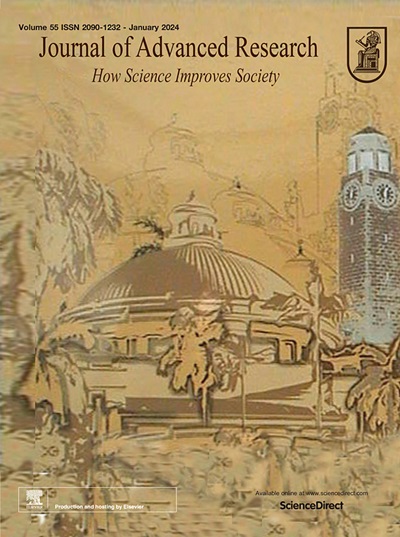Anti-diabetic effect of dicaffeoylquinic acids is associated with the modulation of gut microbiota and bile acid metabolism
IF 11.4
1区 综合性期刊
Q1 MULTIDISCIPLINARY SCIENCES
引用次数: 0
Abstract
Introduction
The human gut microbiome plays a pivotal role in health and disease, notably through its interaction with bile acids (BAs). BAs, synthesized in the liver, undergo transformation by the gut microbiota upon excretion into the intestine, thus influencing host metabolism. However, the potential mechanisms of dicaffeoylquinic acids (DiCQAs) from Ilex kudingcha how to modulate lipid metabolism and inflammation via gut microbiota remain unclear.
Objectives and methods
The objectives of the present study were to investigate the regulating effects of DiCQAs on diabetes and the potential mechanisms of action. Two mice models were utilized to investigate the anti-diabetic effects of DiCQAs. Additionally, analysis of gut microbiota structure and functions was conducted concurrently with the examination of DiCQAs’ impact on gut microbiota carrying the bile salt hydrolase (BSH) gene, as well as on the enterohepatic circulation of BAs and related signaling pathways.
Results
Our findings demonstrated that DiCQAs alleviated diabetic symptoms by modulating gut microbiota carrying the BSH gene. This modulation enhanced intestinal barrier integrity, increased enterohepatic circulation of conjugated BAs, and inhibited the farnesoid X receptor-fibroblast growth factor 15 (FGF15) signaling axis in the ileum. Consequently, the protein expression of hepatic FGFR4 fibroblast growth factor receptor 4 (FGFR4) decreased, accompanied by heightened BA synthesis, reduced hepatic BA stasis, and lowered levels of hepatic and plasma cholesterol. Furthermore, DiCQAs upregulated glucolipid metabolism-related proteins in the liver and muscle, including v-akt murine thymoma viral oncogene homolog (AKT)/glycogen synthase kinase 3-beta (GSK3β) and AMP-activated protein kinase (AMPK), thereby ameliorating hyperglycemia and mitigating inflammation through the down-regulation of the MAPK signaling pathway in the diabetic group.
Conclusion
Our study elucidated the anti-diabetic effects and mechanism of DiCQAs from I. kudingcha, highlighting the potential of targeting gut microbiota, particularly Acetatifactor sp011959105 and Acetatifactor muris carrying the BSH gene, as a therapeutic strategy to attenuate FXR-FGF15 signaling and ameliorate diabetes.
二咖啡酰奎宁酸的抗糖尿病作用与肠道微生物群和胆汁酸代谢的调节有关。
导言:人类肠道微生物群在健康和疾病中发挥着关键作用,特别是通过与胆汁酸(BAs)的相互作用。胆汁酸在肝脏中合成,排入肠道后经过肠道微生物群的转化,从而影响宿主的新陈代谢。然而,Ilex kudingcha中的二咖啡酰奎宁酸(DiCQAs)如何通过肠道微生物群调节脂质代谢和炎症的潜在机制仍不清楚:本研究旨在探讨 DiCQAs 对糖尿病的调节作用及其潜在作用机制。本研究利用两种小鼠模型来研究 DiCQAs 的抗糖尿病作用。此外,在研究 DiCQAs 对携带胆盐水解酶(BSH)基因的肠道微生物群以及 BAs 肠肝循环和相关信号通路的影响的同时,还对肠道微生物群的结构和功能进行了分析:我们的研究结果表明,DiCQAs能通过调节携带BSH基因的肠道微生物群来缓解糖尿病症状。结果:我们的研究结果表明,DiCQAs 可通过调节携带 BSH 基因的肠道微生物群来缓解糖尿病症状。这种调节增强了肠道屏障的完整性,增加了共轭 BAs 的肠肝循环,并抑制了回肠中法尼类固醇 X 受体-成纤维细胞生长因子 15(FGF15)信号轴。因此,肝脏 FGFR4 成纤维细胞生长因子受体 4 (FGFR4) 蛋白表达减少,同时 BA 合成增加,肝脏 BA 瘀积减少,肝脏和血浆胆固醇水平降低。此外,DiCQAs还能上调肝脏和肌肉中的糖脂代谢相关蛋白,包括v-akt小鼠胸腺瘤病毒癌基因同源物(AKT)/糖原合酶激酶3-β(GSK3β)和AMP激活蛋白激酶(AMPK),从而通过下调糖尿病组的MAPK信号通路来改善高血糖和减轻炎症反应:我们的研究阐明了来自I. kudingcha的DiCQAs的抗糖尿病作用和机制,强调了靶向肠道微生物群(尤其是携带BSH基因的Acetatifactor sp011959105和Acetatifactor muris)作为一种治疗策略来减弱FXR-FGF15信号传导和改善糖尿病的潜力。
本文章由计算机程序翻译,如有差异,请以英文原文为准。
求助全文
约1分钟内获得全文
求助全文
来源期刊

Journal of Advanced Research
Multidisciplinary-Multidisciplinary
CiteScore
21.60
自引率
0.90%
发文量
280
审稿时长
12 weeks
期刊介绍:
Journal of Advanced Research (J. Adv. Res.) is an applied/natural sciences, peer-reviewed journal that focuses on interdisciplinary research. The journal aims to contribute to applied research and knowledge worldwide through the publication of original and high-quality research articles in the fields of Medicine, Pharmaceutical Sciences, Dentistry, Physical Therapy, Veterinary Medicine, and Basic and Biological Sciences.
The following abstracting and indexing services cover the Journal of Advanced Research: PubMed/Medline, Essential Science Indicators, Web of Science, Scopus, PubMed Central, PubMed, Science Citation Index Expanded, Directory of Open Access Journals (DOAJ), and INSPEC.
 求助内容:
求助内容: 应助结果提醒方式:
应助结果提醒方式:


